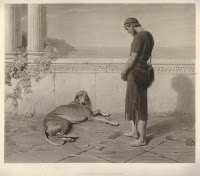Those who have seen the Quentin Tarantino film Once Upon a Time in Hollywood will recall that the movie ends in an orgy of violence, at the centre of which is a ferocious pitbull, called Brandy, who attacks two members of the Manson Family on the command of her master, stuntman Cliff Booth [1].
Anyway, re-watching the above on TV the other night, made me think of the equally harrowing scenes involving savage dogs in Emily Brontë's queer-gothic masterpiece, Wuthering Heights ... [2]
Dogs appear throughout Wuthering Heights and, as critics have pointed out, they not only help us to better understand personality traits of the main human characters, but are also used to presage events about to unfold in the novel. And, of course, they add an extra element of violent horror (as if such were needed in a book which is, in some respects, far more shocking and transgressive than any of Tarantino's movies).
Although poor Lockwood [3] isn't the only victim of a vicious dog attack, the first chapter scene in which he first visits his landlord Heathcliff is the one that immediately comes to mind. Sitting surrounded by snarling dogs with curled lips, including a huge, liver-coloured bitch pointer and a pair of grim-shaggy sheep-dogs, Lockwood attempts to remain calm.
But when Heathcliff goes down into the cellar to fetch some wine and Lockwood is left alone with the dogs, his anxiety levels are significantly raised. Foolishly, he winks and makes faces at the animals and the bitch becomes so infuriated, that she leaps onto his knees.
This, in turn, arouses the other flea-bitten curs lurking about the house and before he knows it, Lockwood is being attacked by half-a-dozen four-footed fiends, who bite at his heels and tear at his clothing. In fear for his life, he picks up a poker from the fireplace in order to try and fend them off.
Brontë thus cleverly reveals that even in a domestic setting, danger and violence are never far from the surface.
Despite the profoundly unsettling nature of his experience, Lockwood returns to Wuthering Heights on a snowy afternoon in chapter two, only to be attacked once more by two hairy monsters named Gnasher and Wolf, who leap at his throat and knock him to the ground when he attempts to leave the remote moorland farmhouse:
"Fortunately, the beasts seemed more bent on stretching their paws, and
yawning, and flourishing their tails, than devouring me alive; but they
would suffer no resurrection, and I was forced to lie till their
malignant masters pleased to deliver me ..."
Later, in chapter six, it's a young Catherine Earnshaw who has the misfortune of being attacked by a dog; this time a bull-dog called Skulker. The devil latches onto her fair ankle, preventing her from fleeing and inflicting a nasty bite.
Despite the pain, Cathy doesn't yell out and, fortunately, Heathcliff is with her. Picking up a large stone, the boy thrusts it between the dog's jaws and tries to shove it down its throat. Eventually, a servant arrives on the scene and he pulls Skulker away, half-throttling the animal whose huge purple tongue hangs out of a mouth that drools with a mixture of blood and saliva.
Finally, it should be noted that not all dogs in the fictional world of Wuthering Heights - or, indeed, in real life - are aggressive: Isabella Linton's little dog, Fanny, is a harmless creature who tragically falls victim to human cruelty; the poor thing being hanged by her abusive husband, Heathcliff, in an attempt to reveal his true nature, stripped of all deceitful softness (see chapter fourteen).
An lllustration by Fritz Eichenberg for the 1943 Random House edition
of Emily Brontë's Wuthering Heights
Notes
[1] So
convincing was professionally-trained dog Sayuri in her role as Brandy, that she was
the recipient of the Wamiz Palm Dog Award for Best Canine Performance. The award was accepted on her behalf by Tarantino, who said he was honoured to do so and described Sayuri as a great actress who gave a great performance.
The final fight scene from Once Upon a Time in Hollywood (2019), featuring Brad Pitt as Cliff Booth, Leonardo DiCaprio as Rick Dalton, and Sayuri as Brandy, can be watched on YouTube by clicking here.
[2] Wuthering Heights was initially published under Brontë's pen name Ellis Bell in 1847. It is rightly considered to be one of the greatest novels written in English, even though early commentators were appalled by its depictions of mental and physical cruelty and its repeated transgression of Victorian morality. One reviewer writing for Graham's Lady Magazine wrote: "It is a compound of vulgar depravity and unnatural horrors."
Lines quoted here from Wuthering Heights are from the Project Gutenberg eBook: click here.
[3] Mr. Lockwood is initially the tale's narrator. He rents a property from Heathcliff - Thrushcross Grange - in order to retreat from society (although soon decides society is far preferable to a life on the North Yorkshire Moors). After chapter four, the main narrator, Nelly Dean - having worked as a servant to three generations of the Earnshaws and two of the Linton family - picks up the story. I'm not going to give further character notes here, assuming that most readers will be familiar with the novel.










